Miele G 7824, G 7823 User Manual
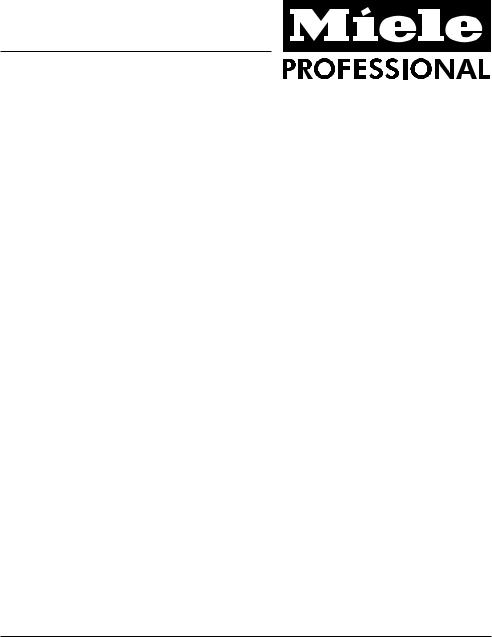
Operating instructions
Washer-disinfector
G 7823 / G 7824
To avoid the risk of accidents or |
en - GB, AU, NZ |
damage to the machine it is |
|
essential to read these instructions |
|
before it is installed, commissioned |
|
and used for the first time. |
M.-Nr. 07 776 620 |

Contents
Warning and safety instructions . . . . . . . . . . . . . . . . . . . . . . . . . . . . . . . . . . . . . 4 Symbols on the appliance . . . . . . . . . . . . . . . . . . . . . . . . . . . . . . . . . . . . . . . . . 8
Intended Use . . . . . . . . . . . . . . . . . . . . . . . . . . . . . . . . . . . . . . . . . . . . . . . . . . . . . 9
Guide to the machine . . . . . . . . . . . . . . . . . . . . . . . . . . . . . . . . . . . . . . . . . . . . . 10 Controls . . . . . . . . . . . . . . . . . . . . . . . . . . . . . . . . . . . . . . . . . . . . . . . . . . . . . . . . . 13
Water softener softener (Optional). . . . . . . . . . . . . . . . . . . . . . . . . . . . . . . . . . . 15 Setting the water softener . . . . . . . . . . . . . . . . . . . . . . . . . . . . . . . . . . . . . . . . . . . 15 Reactivation display. . . . . . . . . . . . . . . . . . . . . . . . . . . . . . . . . . . . . . . . . . . . . . . . 15 Reactivating the water softener . . . . . . . . . . . . . . . . . . . . . . . . . . . . . . . . . . . . . . . 16 Filling the salt container . . . . . . . . . . . . . . . . . . . . . . . . . . . . . . . . . . . . . . . . . . 17 Position the salt container as follows . . . . . . . . . . . . . . . . . . . . . . . . . . . . . . . . 17 Run the reactivation programme . . . . . . . . . . . . . . . . . . . . . . . . . . . . . . . . . . . 18
Automatic mobile unit recognition (Optional). . . . . . . . . . . . . . . . . . . . . . . . . . 19 Mobile unit coding . . . . . . . . . . . . . . . . . . . . . . . . . . . . . . . . . . . . . . . . . . . . . . . . . 20 Setting mobile unit coding . . . . . . . . . . . . . . . . . . . . . . . . . . . . . . . . . . . . . . . . 21
Areas of application. . . . . . . . . . . . . . . . . . . . . . . . . . . . . . . . . . . . . . . . . . . . . . . 23 Protein test . . . . . . . . . . . . . . . . . . . . . . . . . . . . . . . . . . . . . . . . . . . . . . . . . . . . . . . 23 Loading the machine . . . . . . . . . . . . . . . . . . . . . . . . . . . . . . . . . . . . . . . . . . . . . . . 24 Surgical instruments (OP) . . . . . . . . . . . . . . . . . . . . . . . . . . . . . . . . . . . . . . . . . . . 25 Ophthalmology . . . . . . . . . . . . . . . . . . . . . . . . . . . . . . . . . . . . . . . . . . . . . . . . . . . 26 Anaesthetic instruments (AN) . . . . . . . . . . . . . . . . . . . . . . . . . . . . . . . . . . . . . . . . 27 Baby bottles (BC) . . . . . . . . . . . . . . . . . . . . . . . . . . . . . . . . . . . . . . . . . . . . . . . . . 28 Operating theatre shoes (OS) . . . . . . . . . . . . . . . . . . . . . . . . . . . . . . . . . . . . . . . . 30 Transfer trolley for loading and unloading the machine . . . . . . . . . . . . . . . . . . . . 31
Chemical processes and technology. . . . . . . . . . . . . . . . . . . . . . . . . . . . . . . . . 33
Dispensing liquid chemical agents . . . . . . . . . . . . . . . . . . . . . . . . . . . . . . . . . . 38 Preparing the DOS dispensers . . . . . . . . . . . . . . . . . . . . . . . . . . . . . . . . . . . . . . . 39 Fill the containers with the relevant agent . . . . . . . . . . . . . . . . . . . . . . . . . . . . 39 Venting the dispensing system . . . . . . . . . . . . . . . . . . . . . . . . . . . . . . . . . . . . . . . 41 Dispensing system maintenance. . . . . . . . . . . . . . . . . . . . . . . . . . . . . . . . . . . . . . 41 External Dispensing systems. . . . . . . . . . . . . . . . . . . . . . . . . . . . . . . . . . . . . . . . . 41
Operation . . . . . . . . . . . . . . . . . . . . . . . . . . . . . . . . . . . . . . . . . . . . . . . . . . . . . . . 42 Master switch. . . . . . . . . . . . . . . . . . . . . . . . . . . . . . . . . . . . . . . . . . . . . . . . . . . . . 42 Switching on . . . . . . . . . . . . . . . . . . . . . . . . . . . . . . . . . . . . . . . . . . . . . . . . . . . . . 42 Door lock . . . . . . . . . . . . . . . . . . . . . . . . . . . . . . . . . . . . . . . . . . . . . . . . . . . . . . . . 42 To open the door . . . . . . . . . . . . . . . . . . . . . . . . . . . . . . . . . . . . . . . . . . . . . . . . . . 42 To close the door . . . . . . . . . . . . . . . . . . . . . . . . . . . . . . . . . . . . . . . . . . . . . . . . . . 42
2

Contents
Operating levels. . . . . . . . . . . . . . . . . . . . . . . . . . . . . . . . . . . . . . . . . . . . . . . . . . . 43 Starting a programme . . . . . . . . . . . . . . . . . . . . . . . . . . . . . . . . . . . . . . . . . . . . . . 44 Programme sequence . . . . . . . . . . . . . . . . . . . . . . . . . . . . . . . . . . . . . . . . . . . . . . 45 Switching off . . . . . . . . . . . . . . . . . . . . . . . . . . . . . . . . . . . . . . . . . . . . . . . . . . . . . 46 Cancelling a programme . . . . . . . . . . . . . . . . . . . . . . . . . . . . . . . . . . . . . . . . . . . . 46 Interrupting a programme . . . . . . . . . . . . . . . . . . . . . . . . . . . . . . . . . . . . . . . . . . . 47
Data transfer. . . . . . . . . . . . . . . . . . . . . . . . . . . . . . . . . . . . . . . . . . . . . . . . . . . . . 48
Maintenance . . . . . . . . . . . . . . . . . . . . . . . . . . . . . . . . . . . . . . . . . . . . . . . . . . . . . 49 Periodic checks . . . . . . . . . . . . . . . . . . . . . . . . . . . . . . . . . . . . . . . . . . . . . . . . . . . 49 Process validation . . . . . . . . . . . . . . . . . . . . . . . . . . . . . . . . . . . . . . . . . . . . . . . . . 50 Routine checks . . . . . . . . . . . . . . . . . . . . . . . . . . . . . . . . . . . . . . . . . . . . . . . . . . . 50 Cleaning the filters in the wash cabinet . . . . . . . . . . . . . . . . . . . . . . . . . . . . . . . . . 51
Cleaning the coarse filter . . . . . . . . . . . . . . . . . . . . . . . . . . . . . . . . . . . . . . . . . 51 Cleaning the coarse, flat and micro-fine filters . . . . . . . . . . . . . . . . . . . . . . . . . 52 Cleaning the spray arms . . . . . . . . . . . . . . . . . . . . . . . . . . . . . . . . . . . . . . . . . . . . 53 Cleaning the control panel. . . . . . . . . . . . . . . . . . . . . . . . . . . . . . . . . . . . . . . . . . . 54 Cleaning the front of the machine . . . . . . . . . . . . . . . . . . . . . . . . . . . . . . . . . . . . . 54 Cleaning the wash cabinet . . . . . . . . . . . . . . . . . . . . . . . . . . . . . . . . . . . . . . . . . . 54 Cleaning the door seals . . . . . . . . . . . . . . . . . . . . . . . . . . . . . . . . . . . . . . . . . . . . . 54 Mobile units, modules and inserts . . . . . . . . . . . . . . . . . . . . . . . . . . . . . . . . . . . . . 55 Printer (optional) . . . . . . . . . . . . . . . . . . . . . . . . . . . . . . . . . . . . . . . . . . . . . . . . . . 56 Renewing the paper roll . . . . . . . . . . . . . . . . . . . . . . . . . . . . . . . . . . . . . . . . . . 56 Renewing the colour cassette . . . . . . . . . . . . . . . . . . . . . . . . . . . . . . . . . . . . . 56
After sales service . . . . . . . . . . . . . . . . . . . . . . . . . . . . . . . . . . . . . . . . . . . . . . . . 57
Converting the type of heating . . . . . . . . . . . . . . . . . . . . . . . . . . . . . . . . . . . . . . 58 Converting from steam to electric heating or from electric to steam . . . . . . . . 58
Electrical connection . . . . . . . . . . . . . . . . . . . . . . . . . . . . . . . . . . . . . . . . . . . . . 59
Plumbing. . . . . . . . . . . . . . . . . . . . . . . . . . . . . . . . . . . . . . . . . . . . . . . . . . . . . . . . 60
Technical data . . . . . . . . . . . . . . . . . . . . . . . . . . . . . . . . . . . . . . . . . . . . . . . . . . . 61
Optional extras. . . . . . . . . . . . . . . . . . . . . . . . . . . . . . . . . . . . . . . . . . . . . . . . . . . 62
Special processes - OXIVARIO and ORTHOVARIO . . . . . . . . . . . . . . . . . . . . . 63 Description of the machine . . . . . . . . . . . . . . . . . . . . . . . . . . . . . . . . . . . . . . . . . . 63 Areas of application . . . . . . . . . . . . . . . . . . . . . . . . . . . . . . . . . . . . . . . . . . . . . 64 Warning and Safety instructions . . . . . . . . . . . . . . . . . . . . . . . . . . . . . . . . . . . . . . 65 Connecting the H2O2 solution container . . . . . . . . . . . . . . . . . . . . . . . . . . . . . . . . 65 Disposal of your old machine . . . . . . . . . . . . . . . . . . . . . . . . . . . . . . . . . . . . . . . 66
3

Warning and safety instructions
This appliance complies with all relevant legal safety requirements. Please note that incorrect use can lead to personal injury and damage to property.
To avoid the risk of accidents and damage to the appliance, please read these instructions carefully before starting to use it. Keep these instructions in a safe place for reference, and pass them on to any future user.
Correct application
This washer-disinfector is designed for use with the applications described in these Operating Instructions only.
Alterations or conversions to the machine, or using it for purposes other than those for which it was designed, are not permitted and could be dangerous.
This machine must only be used for cleaning and disinfecting instruments or medical devices if the manufacturer has stated that they are suitable for machine processing. Manufacturer's cleaning and maintenance instructions for instruments etc. must also be observed.
Miele cannot be held liable for damage caused by improper or incorrect use or operation of the machine.
This machine is intended for indoor use only.
This machine is not designed for use in mobile installations unless a risk assessment of the installation has been carried out by a suitably qualified engineer.
Please pay attention to the following notes to avoid injury and damage.
This machine should be commissioned and then maintained by a Miele authorised and trained service technician only. A Miele service contract is recommended to ensure compliance with GLP Guidelines and the Medical Devices Directive. Unauthorised repairs could be dangerous, for which the manufacturer cannot be held liable.
Do not install the machine in an area where there is any danger of explosion or of freezing conditions.
The electrical safety of this machine can only be guaranteed if connected to a correctly installed earthing system on site. It is most important that this basic safety requirement is present and tested regularly, and where there is any doubt the on-site electrical system should be inspected by a qualified electrician.
The manufacturer cannot be held liable for damage or injury caused by the lack of or inadequacy of an effective earthing system (e.g. electric shock).
A damaged or leaking machine could be dangerous and compromise your safety. Disconnect the machine from the mains immediately and call the Miele Service Department.
Personnel operating the appliance should be trained regularly. Untrained personnel must not be allowed access to the machine or its controls.
4

Warning and safety instructions
Take care when handling chemical agents such as cleaning agent, neutralising agent, rinsing agent etc. These may contain irritant or corrosive ingredients.
Please follow the manufacturer's safety instructions. Wear protective gloves and goggles. With all chemical agents, the manufacturer's safety instructions and safety data sheets must be observed.
The machine is designed for operation with water and recommended additive chemical agents only. Organic solvents and flammable liquid agents must not be used in this machine. These could cause an explosion, damage rubber and plastic components in the machine, and cause liquids to leak out of the machine.
The water in the cabinet must not be used as drinking water.
Be careful when sorting items with sharp pointed ends and positioning them in the machine that you do not hurt yourself or create a danger for others. Sharp knives etc. should be placed in baskets with the pointed ends facing downwards.
When using this machine in the higher temperature ranges, be especially careful not to scald or burn yourself or come into contact with irritant substances when opening the door. Where disinfecting agents are used there is a danger of inhaling toxic fumes.
Where there is a risk of toxic or chemical substances occuring in the suds solution (e.g. aldehyde in the disinfecting agent), it is essential to regularly check door seals and make sure that the steam condensor is functioning correctly.
Opening the machine door during a programme interruption carries particular risks in such circumstances.
Should personnel accidentally come into contact with toxic vapours or chemical agents, follow the emergency instructions given in the manufacturer's safety data sheets.
Mobile units, modules, inserts and the load must be allowed to cool down before they are unloaded. Any water remaining in containers could still be very hot. Empty them into the wash cabinet before taking them out.
After using the hot air drying unit, open the door to allow the everything in the cabinet from the load itself to the mobile units, modules and inserts to cool down.
Steam heating is permissible up to a pressure of 1000 kPa (10 bar). This corresponds to a water steam temperature of 179°C.
Never clean the machine or near vicinity with a water hose or a pressure washer.
The machine must be disconnected from the mains electricity supply before any maintenance or repair work is carried out. Do not reconnect it until the maintenance or repair work has been successfully completed.
5

Warning and safety instructions
The following points should be observed to assist in maintaining quality standards when processing medical devices, in order to protect patients, and to avoid damage to the loads being cleaned.
If the machine is being used for disinfection in accordance with official regulations on the control of epidemics, the steam condenser and its connections to and from the wash cabinet must be cleaned and disinfected whenever any repairs are carried out or parts replaced.
If it is necessary to interrupt a programme in exceptional circumstances, this may only be done by authorised personnel.
The standard of cleaning and disinfection in the disinfection programmes must be routinely confirmed by the user. The process should be validated on a regular basis, and checked against documented control results. Chemical disinfection procedures should also be validated using chemical or bio indicators.
For thermal disinfection, use temperatures and temperature holding times to achieve the required infection prophylaxis in accordance with current health and safety regulations.
Disinfection programmes which use a chemical disinfecting agent at moderate temperatures such as 65 °C or lower are not recognised by §18 IfSG for disinfection. They should only be used for items which cannot withstand the higher temperatures used by thermal disinfection. The range of effective disinfection is based on claims made by the producer of the disinfecting agent. Their instructions on handling, use and effectiveness must be observed. The use of chemical disinfection procedures is the responsibility of the operator.
Theatre (OP) shoes should only be cleaned and disinfected in a machine installed specifically for this purpose.
Only use chemical agents formulated for special processes and approved by Miele for use with this machine. Use of unsuitable agents could adversely affect the components of the machine. In the event of any damage or material deterioration please contact your Miele application specialist.
Pre-treatments with cleaning or disinfecting agents can create foam, as can certain types of soiling and chemical agents. Foam can have an adverse effect on the disinfection and cleaning result.
Foam must not be able to escape from the wash cabinet. It would hinder the correct functioning of the machine.
Check the process used regularly to monitor foaming levels.
6

Warning and safety instructions
To avoid the risk of damage to the machine and any accessories used with it caused by chemical agents, soiling and any reaction between the two please read the notes in "Chemical Processes and Technology".
Where a chemical agent is recommended on technical application grounds (e.g. a cleaning agent), this does not imply that the manufacturer of the machine accepts liability for the effect of the chemical on the items being cleaned.
Please be aware that changes in formulation, storage conditions etc. which may not be publicised by the chemical manufacturer, can have a negative effect on the cleaning result.
When using cleaning agents and specialised products it is essential that the manufacturer's instructions are followed. Chemicals must only be used for the purpose they are designed for and in the situation specified, to the exclusion of other chemicals, to avoid such dangers as chemical reactions and material damage.
In critical applications where very stringent requirements have to be met, it is strongly recommended that all the relevant factors for the process, such as chemical agents, water quality etc. are discussed with the Miele Application Technology specialists.
If the cleaning result is subject to particularly stringent requirements, a regular quality control test should be carried out by the user to ensure that required standards of cleanliness are being achieved.
Mobile units, modules and inserts should only be used for the purpose they are designed for.
Hollow instruments must be thoroughly cleaned, internally and externally.
Empty any containers or utensils before arranging them in the machine.
Do not allow any remains of acids or solvents, and in particular hydrochloric acid or chloride solutions, to get into the wash cabinet. Similarly avoid any materials with a corrosive effect. The presence in compounds of any solvents should be minimal (especially those in hazard class A1).
Ensure that solutions or steam containing hydrochloric acid do not come into contact with the steel outer casing of the machine, to avoid any corrosion damage.
Please follow the advice on installation in these instructions and the separate Installation Instructions.
Using accessories
Only use genuine Miele original accessories with this machine. Consult Miele on the type and application of such equipment.
Only use Miele mobile units, modules and inserts in this machine. Using accessories made by other manufacturers, or making modifications to Miele accessories, can result in unsatisfactory cleaning and disinfecting results, for which Miele cannot be held liable. Any resultant damage would also invalidate the machine guarantee.
7

Warning and safety instructions
Only use chemical agents which have been approved by their manufacturer for use in the application you are using. The chemical agent manufacturer is responsible for any negative influences on the material the load is made from and for any damage they may cause to the machine.
Symbols on the appliance
Warning:
Observe the operating instructions.
Warning:
Danger of electric shock.
Disposing of your old machine
Please note that the machine may have contamination from blood or other bodily fluids in it and must be decontaminated before disposal.
For environmental and safety reasons ensure the machine is completely drained of any residual water, chemical residues and cleaning agent. Observe safety regulations and wear safety goggles and gloves.
Make the door lock inoperable, so that children cannot accidentally shut themselves in. Then make appropriate arrangements for its safe disposal.
For tank system machines ensure that any water is emptied out of the tank.
The manufacturer cannot be held liable for damage caused by non-compliance with these Warning and Safety instructions.
8

Intended Use
This washer-disinfector can be used to clean, rinse, disinfect (thermally and chemically) and dry a wide range of reusable medical devices.
Follow the manufacturer's instructions (according to EN ISO 17664) on how to process their items by machine.
Examples of application areas:
–surgical instruments,
–minimally invasive instruments,
–anaesthetic and intensive care instruments,
–baby bottles and teats,
–stainless steel and aluminium containers (including anodised aluminium),
–operating theatre shoes.
Processing medical devices by machine achieves reproducible results, and should be used in preference to processing them by hand.
Where disinfection is required for the protection of staff and/or patients, a thermal disinfection programme, e.g. the DESIN vario TD programme, should be selected.
The parameters for thermal disinfection according to EN ISO 15883-1 (A0 concept) vary depending on the disinfection standard required. They are 80 °C (+ 5 °C, - 0 °C) with a 10 min holding time (A0 600) or 90 °C (+ 5 °C, - 0 °C) with a 5 min holding time
(A0 3000). An A0 value of 3000 is suitable for deactivating the HBV virus.
National health and safety regulations regarding disinfection must also be observed.
The cleaning programme as well as any chemical agents must be chosen according to the type of soiling and load being processed.
The agents used for processing the products should be selected to suit the level of cleaning required as well as the method of analysis used.
The cleaning result must ensure that the instruments can be disinfected correctly, that no residues are left behind, that subsequent sterilisation can be carried out and that the instruments can be used again safely. Medical devices are best processed using the DESIN vario TD programme, or the ORTHOVARIO or OXIVARIO programme where applicable.
The use of a suitable carrier (mobile unit, module, insert etc.) is important to ensure the adequate cleaning of the load. Examples are given in the section "Areas of application".
The washer-disinfector is programmed to carry out the final rinse with mains water or with processed water of a quality to suit the application (e.g. aqua destillata, purified water, de-ionised water, demineralised water).
This machine complies with EN ISO 15883 for validation purposes.
9
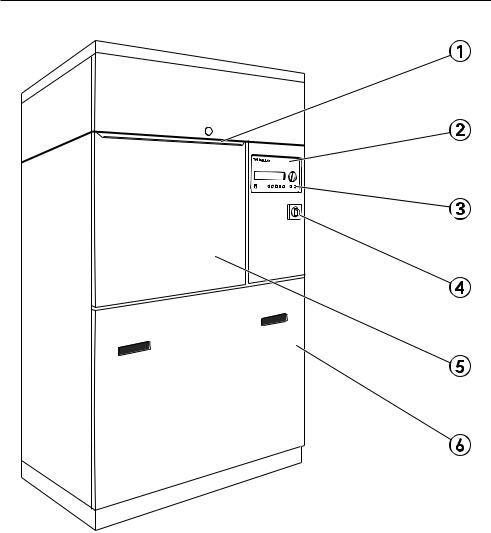
Guide to the machine
Unclean side
Handle
Profitronic electronic controls (see the Programming manual for more information)
Controls
Master switch (with emergency cut-off function for service work)
Drop-down door (closed)
Service panel
10

Guide to the machine
Unclean side
Salt container connection point (for the water softener)
Filter combination
Drop-down door (open)
Containers for dispensing systems DOS 1 / DOS 3
(DOS 2 / DOS 4 optional)
11
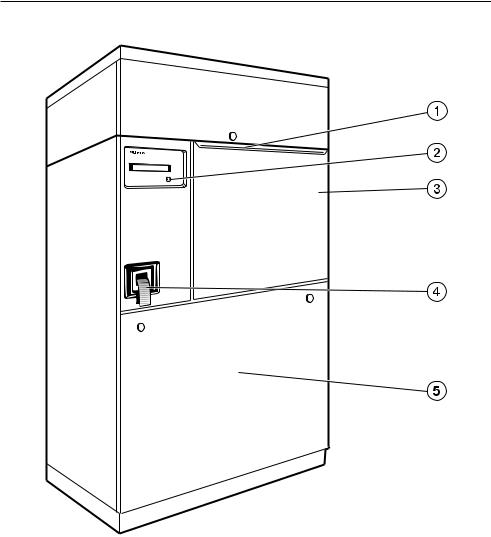
Guide to the machine
Clean side (G 7824 only )
Handle |
Printer (optional) |
Door release |
G 7823: on the unclean side |
|
|
Drop-down door (closed) |
Service panel |
|
12
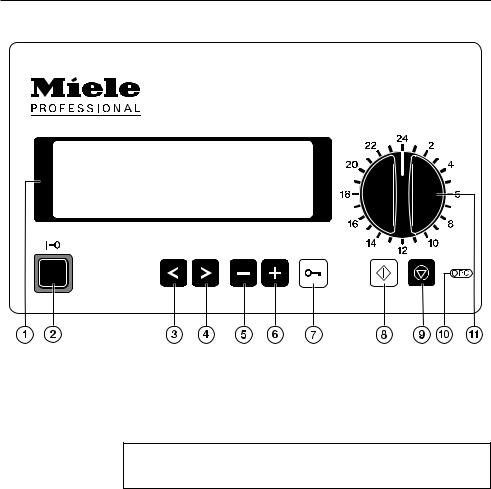
Guide to the machine
Controls
Display
with screen saver;
i.e. background lighting switches off automatically after 15 mins. Press any button to switch the display back on again.
Faults occurring during operation are shown in the display.
They are listed in a chart in the Programming manual.
On/Off button (I-0)
Cursor button: left
Moves the cursor to the left:
–to the previous menu point
–to the previous parameter
–to the previous input position
13

Guide to the machine
Cursor button: right
Moves the cursor to the right:
–to the next menu point
–to the next parameter
–to the next input position
Minus button
–Selects programmes from position 24 upwards
–Scrolls back page by page in menus
–Is used for entering numbers and letters
–Alters pre-settings e.g. service parameters
Plus button
–Selects programmes from position 24 upwards
–Scrolls forward page by page in menus
–Is used for entering numbers and letters
–Alters pre-settings e.g. service parameters
Door switch
Start button
–Starts programmes
–Activates input mode
–Confirms activated values and settings
–Confirms menu points for entry into the relevant sub-menu
Stop button
–Cancels a programme
–Exits from input screen without saving
–Exits from menu screen
Service interface
Programme selector
Selects programme places 1-23
14
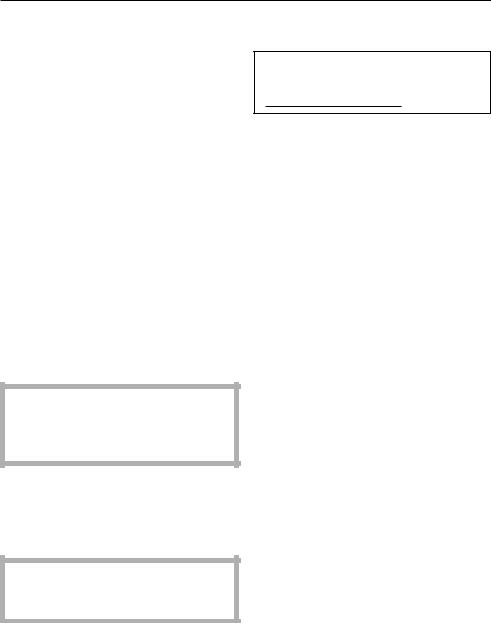
Water softener softener (Optional)
In order to achieve good cleaning results, the washer-disinfector needs to operate with soft water. Hard water results in the build-up of calcium deposits on instruments, etc, and in the washer-disinfector.
Mains water with a hardness level higher than 0.7 mmol/l (4° d – German scale) needs to be softened. This takes place automatically in the integrated water softener.
–The water softener requires reactivation salt.
–The washer-disinfector must be programmed to correspond to the water hardness in your area.
–Your local water authority will be able to advise you on the water hardness in your area.
The water softener is set ex-works for a hardness level of 3.4 mmol/l or 19°d.
If your water hardness differs from this (even if it is below 0.7 mmol/l or 4°d) you will need to programme the level into your machine.
Where the water hardness fluctuates e.g. between 1.4 - 3.1 mmol/l (8 - 17 °d German scale) always programme the washer-disinfector to the higher value (3.1 mmol/l in this example).
The built-in water softener has settings from 1 °d - 60 °d (0.2 - 10.8 mmol/l).
For future servicing it is useful to make a note of your water hardness level.
Enter your water hardness level here:
°d or mmol/l
Setting the water softener
When the machine is first commissioned the Miele service technician has to set the machine for your local water hardness level (see Programme manual, Operation/Reactivation).
Reactivation display
After a certain number of cycles the message REACTIVATION will appear in the display to warn you that the water softener is depleted and cannot supply any more softened water. As soon as the programme has finished reactivation salt will need to be replenished.
If this cannot be done immediately, and further cleaning cycles have been carried out, the reactivation process will need to be carried out twice in succession.
15
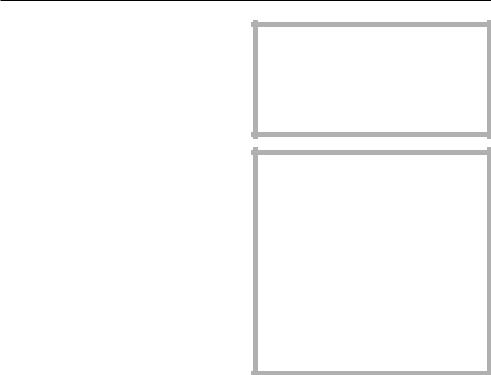
Water softener softener (Optional)
Reactivating the water softener
Please only use special coarse grained reactivation salt with granules of approx. 1-4 mm. Do not use other types of salt, e.g. table salt, agricultural or gritting salt. These could contain components which are insoluble in water which could result in damage to the water softener. If in doubt consult the Miele Professional Department.
The salt container holds approx. 2 kg of salt.
If only fine grained reactivation salt is available please consult the MIELE Professional Sales office for advice.
Salt with granules 4 mm must not be used in this machine.
Inadvertently filling the salt reservoir with cleaning agent can cause serious damage to the water softener and damage the filter insert, and cause pressure to build-up in the salt container. To avoid the risk of injury please exercise caution when removing the salt container as there may be irritant alkaline solutions present.
Before filling the salt container make sure that you have picked up the right packet of reactivation salt.
16
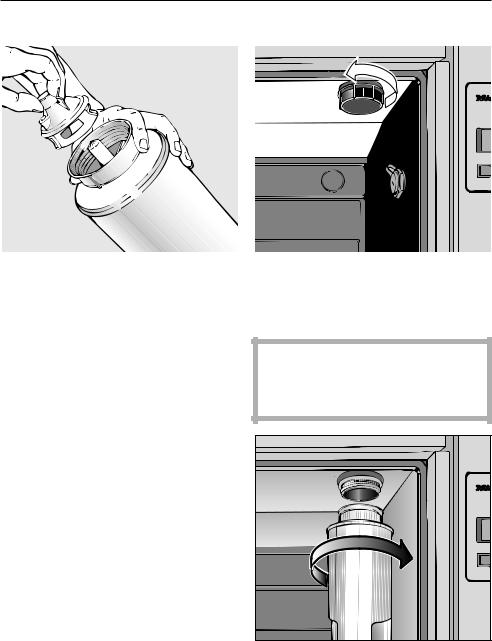
Water softener softener (Optional)
Filling the salt container |
Position the salt container as follows |
|||||
|
|
|
|
|
|
|
|
|
|
|
|
|
|
|
|
|
|
|
|
|
|
|
|
|
|
|
|
|
|
|
|
|
|
|
|
|
|
|
|
|
|
|
|
|
|
|
|
|
|
|
|
|
|
|
|
|
|
|
|
|
|
|
|
|
|
|
|
|
|
|
|
|
|
|
|
|
Unscrew the filter insert from the salt container and remove.
Fill the salt container with reactivation salt and screw the filter insert back in place.
Remove any mobile units from the cabinet.
Unscrew the plastic cap situated in the top right-hand side of the cabinet.
There will be a small amount of residual water in the cap. Take care as it may be hot from the previous programme.
Screw the salt container firmly onto the socket.
17

Water softener softener (Optional)
Run the reactivation programme
Close the door.
Open the stopcocks.
Select the REACTIVATION programme.
The programme will run automatically.
Then:
Switch off the machine.
Carefully unscrew the salt container, making sure any water pressure still remaining can depressurise. Do not use force!
If the container will not come off manually please contact the Miele Service Department.
Replace the plastic cap.
Push the mobile unit back into the cabinet.
Turn off the stopcocks.
Empty the salt container. Do not empty it into the wash cabinet.
Rinse the salt container and filter insert with clean water.
The water pressure (flow pressure at the take off point) must be at least 100 kPa (1 bar).
If it is below100 kPa (1 bar) or if it fluctuates a lot, the water softener will not work properly. After reactivation, salt remains may still be found in the salt container.
To use up salt remains and to rinse out the water softener, the REACTIVATION programme must be carried out again.
18

Automatic mobile unit recognition (Optional)
In operating level C the automatic mobile unit recognition system (AWK) allocates programme places from 1 - 15 to mobile units with the correct coding.
The unit coding (on the mobile unit) and the programme place with the corresponding programme (in the electronic control unit) have to match each other.
To do this:
Each mobile unit must be coded before being used for the first time (see "Coding the mobile unit"), and
The programme for which the mobile unit is coded must be allocated to the correct programme place.
See "System function - Selector switch organisation" in the Programming manual for information on how to change programme positions.
Before starting a programme it is absolutely essential that you check that the programme shown in the display is the correct one for the mobile unit being used.
Otherwise inadequate cleaning or disinfection could be the result. Please make sure, that the places assigned for the programmes using Automatic mobile unit recognition are not changed around arbitrarily.
19
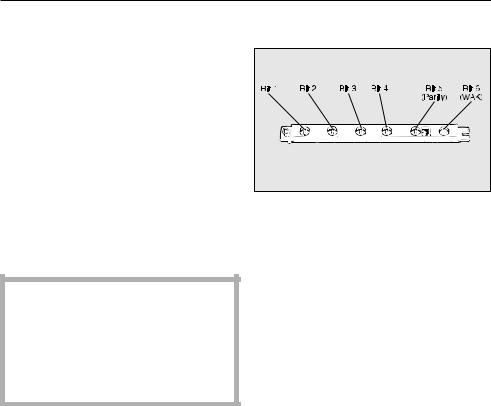
Automatic mobile unit recognition (Optional)
Mobile unit coding
The automatic mobile unit recognition feature assigns a programme place to a mobile unit. The mobile units must be coded with a magnetic strip (via a Bit combination).
In operating level C, the only programme available for a coded mobile unit is the one assigned to the corresponding programme place.
After a coded mobile unit has been put into the machine and the door closed, the automatic mobile unit recognition system will select the allocated programme.
Make sure that there are no small metallic objects or instrument parts attracted to the magnetic strip, in particular to the underside of it. Any metallic objects on the strip can result in the coding being incorrectly read.
Press to start the programme.
Coding is effected through 5 Bits:
–Bits 1 to 4 define the mobile unit code,
–Bit 5 serves as a control (Parity Bit).
Bit 6 controls the volume of inflowing water and the circulation pump for mobile units with side coupling (WAK). Its settings cannot be altered.
Mobile units without side coupling are coded with tracks which do not contain Bit 6.
20
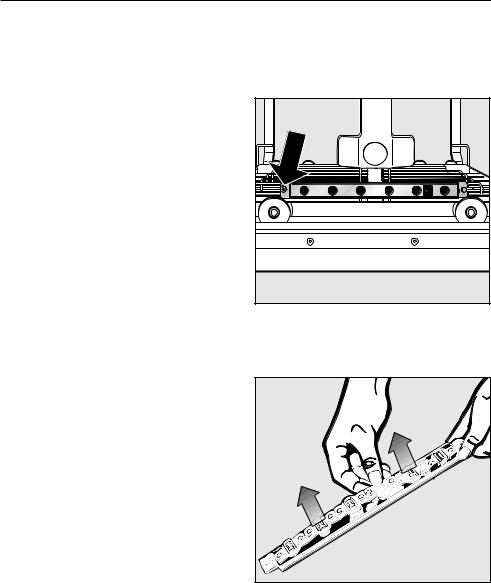
Automatic mobile unit recognition (Optional)
Mobile unit coding strip
15 different codes can be set. They are assigned to programme places 1 to 15.
Under "System function, Selector switch organisation" the matching programmes have to be put into the first 15 programme places.
Programme |
Bit |
Bit 2 |
Bit 3 |
Bit 4 |
Bit 5 |
place |
1 |
|
|
|
Parity |
|
|
|
|
|
Bit |
|
|
|
|
|
|
- |
0 |
0 |
0 |
0 |
0 |
1 |
I |
0 |
0 |
0 |
I |
2 |
0 |
I |
0 |
0 |
I |
3 |
I |
I |
0 |
0 |
0 |
4 |
0 |
0 |
I |
0 |
I |
5 |
I |
0 |
I |
0 |
0 |
6 |
0 |
I |
I |
0 |
0 |
7 |
I |
I |
I |
0 |
I |
8 |
0 |
0 |
0 |
I |
I |
9 |
I |
0 |
0 |
I |
0 |
10 |
0 |
I |
0 |
I |
0 |
11 |
I |
I |
0 |
I |
I |
12 |
0 |
0 |
I |
I |
0 |
13 |
I |
0 |
I |
I |
I |
14 |
0 |
I |
I |
I |
I |
15 |
I |
I |
I |
I |
0 |
|
|
|
|
|
|
The coded total must be an even number.
The settings on Bit 6 (WAK) are not included in this calculation.
If the coded total gives an odd number, the message CHECK MOBILE UNIT RECOGNITION appears.
If the mobile unit code equals 0, the message NO MOBILE UNIT RECOGNITION appears. In neither case can the programme be started, The mobile unit recognition function must be re-set.
Setting mobile unit coding
To set or alter the coding of a mobile unit with automatic recognition (AWK), proceed as follows:
Unscrew the track with AWK (using an allen key) and remove from the retainer.
Remove the magnetic strip from the track.
21
